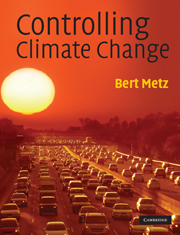Book contents
- Frontmatter
- Contents
- Preface
- 1 Climate change and its impacts: a short summary
- 2 Greenhouse gas emissions
- 3 Keeping climate change within sustainable limits: where to draw the line?
- 4 Development first
- 5 Energy Supply
- 6 Transportation
- 7 Buildings
- 8 Industry and waste management
- 9 Land use, agriculture, and forestry
- 10 How does it fit together?
- 11 Policies and measures
- 12 International climate change agreements
- Index
- Plate section
2 - Greenhouse gas emissions
Published online by Cambridge University Press: 05 June 2012
- Frontmatter
- Contents
- Preface
- 1 Climate change and its impacts: a short summary
- 2 Greenhouse gas emissions
- 3 Keeping climate change within sustainable limits: where to draw the line?
- 4 Development first
- 5 Energy Supply
- 6 Transportation
- 7 Buildings
- 8 Industry and waste management
- 9 Land use, agriculture, and forestry
- 10 How does it fit together?
- 11 Policies and measures
- 12 International climate change agreements
- Index
- Plate section
Summary
What is covered in this chapter?
This is a book about controlling man-made climate change. Therefore we start with the man-made gases and aerosols that are responsible for climate change. They fall into two categories: (1) the six gases covered under the Kyoto Protocol: carbon dioxide, methane, nitrous oxide, sulphur hexafluoride, perfluorinated compounds, and hydrofluorocarbons; (2) ozone, chlorofluorocarbons, and aerosols. Their emissions sources are discussed in terms of the processes and the sectors of the economy where they emerge and the contributions of different countries. The strong increase and continuing upward trends of greenhouse gas emissions form a big challenge for emission reduction.
Contributions to warming
As discussed in Chapter 1, the contribution of gases and aerosols to warming depends on their effectiveness to retain solar radiation (called radiative properties) and their concentration in the atmosphere.
Controlling climate change therefore requires control of these concentrations. And concentrations are the combined result of input (emissions) and disappearance of gases. It is like filling a bath. If we want to control the water level, and the drain is closed, it means the tap has to be shut. And so it works with greenhouse gases (see Figure 2.1). Greenhouse gases disappear very slowly from the atmosphere. It takes 100 years before half of an amount of carbon dioxide (CO2) put into the atmosphere has disappeared, but about 20% stays in the atmosphere for thousands of years. For methane (CH4) it takes 12 years for two-thirds of it to disappear (called the ‘lifetime’).
- Type
- Chapter
- Information
- Controlling Climate Change , pp. 30 - 50Publisher: Cambridge University PressPrint publication year: 2009
- 2
- Cited by



